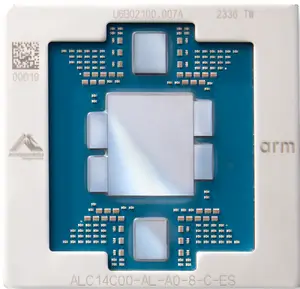From WikiChip
Editing annapurna labs/graviton/graviton4
Warning: You are not logged in. Your IP address will be publicly visible if you make any edits. If you log in or create an account, your edits will be attributed to your username, along with other benefits.
The edit can be undone.
Please check the comparison below to verify that this is what you want to do, and then save the changes below to finish undoing the edit.
This page supports semantic in-text annotations (e.g. "[[Is specified as::World Heritage Site]]") to build structured and queryable content provided by Semantic MediaWiki. For a comprehensive description on how to use annotations or the #ask parser function, please have a look at the getting started, in-text annotation, or inline queries help pages.
| Latest revision | Your text | ||
| Line 33: | Line 33: | ||
Graviton4 features a 7-chiplet design similar to its predecessor, {{\\|Graviton3}}. This chip features 96 cores, 50% more than the prior generation. The core implementation was updated to Arm's {{armh|Neoverse V2}} microarchitecture with 2x256b [[Scalable Vector Extension|SVE]] support, also bringing support up to [[Armv9.0]] ISA for the first time. The chip supports up to 12 channels for DDR5 ECC DIMMs with data rates of up to 5600 MT/s. The Graviton4 tripled the number of PCIe lanes to 96 lanes of PCIe 5.0. | Graviton4 features a 7-chiplet design similar to its predecessor, {{\\|Graviton3}}. This chip features 96 cores, 50% more than the prior generation. The core implementation was updated to Arm's {{armh|Neoverse V2}} microarchitecture with 2x256b [[Scalable Vector Extension|SVE]] support, also bringing support up to [[Armv9.0]] ISA for the first time. The chip supports up to 12 channels for DDR5 ECC DIMMs with data rates of up to 5600 MT/s. The Graviton4 tripled the number of PCIe lanes to 96 lanes of PCIe 5.0. | ||
| − | + | ||
The Graviton4 is the first chip from the Graviton family to feature multiprocessing support. The chip introduced dual-socket support with full coherency for up to 192 vCPUs and DDR5 channels on a single server. The Graviton4 also expanded encryption support to the new multi-socket coherency links as well as to the Nitro cards interfaces. The full platform can be configured to run in a number of modes that can potentially offer additional power saving: two non-coherent virtual systems, one coherent virtual system, two metal systems, or one metal system. | The Graviton4 is the first chip from the Graviton family to feature multiprocessing support. The chip introduced dual-socket support with full coherency for up to 192 vCPUs and DDR5 channels on a single server. The Graviton4 also expanded encryption support to the new multi-socket coherency links as well as to the Nitro cards interfaces. The full platform can be configured to run in a number of modes that can potentially offer additional power saving: two non-coherent virtual systems, one coherent virtual system, two metal systems, or one metal system. | ||
| − | |||
=== Packaging === | === Packaging === | ||
The Graviton4 features a 7-chiplet architecture similar in design to the Graviton3. The compute SoC die sits in the middle with 4 DDR memory controller dies and 2 PCIe controller dies. Each DDR memory controller features support for 3 memory channels - two dies to the east and two dies to the west for a total of 6 memory channels on each side. There are two PCIe controller dies - one to the north and one to the south of the chip. The four DDR memory controller dies are interconnected with the SoC via embedded silicon bridges in the package.Unlike the {{\\|Graviton3}}, the two PCIe controller dies are not abutting the compute SoC die and are no longer controller via an embedded bridge in the package. | The Graviton4 features a 7-chiplet architecture similar in design to the Graviton3. The compute SoC die sits in the middle with 4 DDR memory controller dies and 2 PCIe controller dies. Each DDR memory controller features support for 3 memory channels - two dies to the east and two dies to the west for a total of 6 memory channels on each side. There are two PCIe controller dies - one to the north and one to the south of the chip. The four DDR memory controller dies are interconnected with the SoC via embedded silicon bridges in the package.Unlike the {{\\|Graviton3}}, the two PCIe controller dies are not abutting the compute SoC die and are no longer controller via an embedded bridge in the package. | ||
Facts about "AWS Graviton4 - Annapurna Labs (Amazon)"
